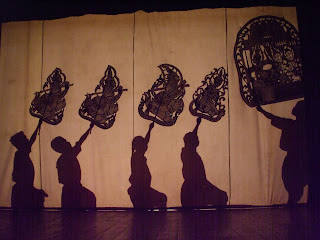Having found a taxi driver with the grandest smile ever, I hired him for my first days' temple exploration. Armed with sunblock, DEET, first-aid kit (oh bless-ed be nursing education), chocolate crossiants, my now well-traveled camera, and my gortex, we set off in the early morning rain. The empty road unfolded itself around bends, through massive temple grounds and snaked its way along the 37km of rice paddies to the base of some mountains. An hour later, we arrived at the vacant Kbal Spaen. First impressions fall hard on virgin-temple minds such as mine. And this one will be hard to beat.
We traversed up the wet tree-rooted trail, the jungle consuming our footsteps moments after they fell. Birds flitted here and there, ushering in the morning with their songs. Small rays of sunlight snuck in just enough to illuminate the dew drops dangling off jungle vines and the forest floor. As much as I wanted to linger, I was bent on getting to the top for the serenity of waterfalls and ancient carvings for myself. And THAT, I got! The river washed over the thousand lingas and two yonis (those lucky yonis ;) ), splashing onto platform carvings of Sivas and Vishnus along the riverbed. What a special site. Having discovered it early this morning solo, I questioned what it must have been like to have actually discovered this ancient site a hundred years ago.
My mind whirling from ecstatic spirit, I found my way down. Passing a lookout that begged for a tarzan swoop into the jungle below, I heard some climbing Korean tourists bellowing out their morning “songs” in the hopes of some echo that never spoke back. We were soon on the road again for my next Dora the Explorer experience.
Banteay Srei was far from the solo standout Kbael Spean abducted me by. But regardless, I was able to find some peace amongst the crowds impossible to capture with a camera. Though not officially part of the mecca of the 3000km sprawl of Angkor Wat, this temple is still endowed with the recognition of a World Heritage Site. Nicknamed “the woman's temple”, this most-intricately carved site was actually built by a king's servants. Its rosy colored sandstone glittered in the early morning sun.
Taking my time in each site and determined to experience the quality of the temples' beauty rather than their quantity, I slowly worked through the ancient spiritual art. Then, I relinquished the reigns to my driver, Nget. He swept me off to a temple I had known little about...Bantey Samre. Part of the Eastern cluster of temples in Angkor Wat, it is isolated far from the “little” and “big” temple circuits routed by world-wide temple-trampling tour groups. Its remoteness gave it a romanticly spiritual charm easily felt by those open to it. Many times I found myself alone, tiptoeing through its monumental air. I took precautions to make no sound, and temper my breathing to but a whisper. What can I say, the space just called for it.
Startled by a priest peeking his head out from a hidden altar, he beckoned me forth. He then offered me a burning incense stick to place in the altar, tied a thread of protection around my wrist, blessed it with prayers and an orchid blossom dipped in holy water, and then insisted on explaining many of the temple carvings I had explored. Feeling honored, I thanked him profusely and then left the temple knowing my day of temple wandering needed to end on this high note. What an amazing day.
























